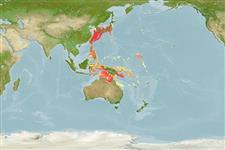Élasmobranches (requins et raies) (sharks and rays) >
Carcharhiniformes (Ground sharks) >
Triakidae (Houndsharks) > Galeorhininae
Etymology: Hemitriakis: hemi-, from hemisys (Gr.), half, being a genus that Herre believed was “most closely related” to Triakis. (See ETYFish); japanica: -ica (L.), belonging to: Japan, type locality. (See ETYFish).
More on authors: Müller & Henle.
Environment: milieu / climate zone / depth range / distribution range
Écologie
marin démersal; profondeur 20 - 345 m (Ref. 86942). Subtropical; 40°N - 19°N, 112°E - 141°E
Northwest Pacific: China, Taiwan, Korea, and Japan. Nominal records from Ambon, Indonesia (unconfirmed and based on a specimen close to if not identical to Hemitriakis abdita) and New Caledonia (Ref. 13563).
Length at first maturity / Taille / Poids / Âge
Maturity: Lm 91.5, range 81 - 102 cm
Max length : 110 cm TL mâle / non sexé; (Ref. 244); 120.0 cm TL (female); âge max. reporté: 15 années (Ref. 9031)
Occurs close inshore and offshore down to at least 100 m depth. Presumably feeds on small fishes, cephalopods and crustaceans. Ovoviviparous, with 8 to 22 young in a litter. Size at birth about 20 to 21 cm. Utilized for human consumption.
Ovoviviparous, embryos feed solely on yolk (Ref. 50449).
Compagno, L.J.V., 1984. FAO Species Catalogue. Vol. 4. Sharks of the world. An annotated and illustrated catalogue of shark species known to date. Part 2 - Carcharhiniformes. FAO Fish. Synop. 125(4/2):251-655. Rome: FAO. (Ref. 244)
Statut dans la liste rouge de l'IUCN (Ref. 130435)
Menace pour l'homme
Harmless
Utilisations par l'homme
Pêcheries: commercial
Outils
Articles particuliers
Télécharger en XML
Sources Internet
Estimates based on models
Preferred temperature (Ref.
123201): 9.7 - 27, mean 20.2 °C (based on 252 cells).
Phylogenetic diversity index (Ref.
82804): PD
50 = 0.5156 [Uniqueness, from 0.5 = low to 2.0 = high].
Bayesian length-weight: a=0.00427 (0.00183 - 0.00992), b=3.04 (2.83 - 3.25), in cm total length, based on LWR estimates for this (Sub)family-body shape (Ref.
93245).
Niveau trophique (Ref.
69278): 4.4 ±0.4 se; based on diet studies.
Résilience (Ref.
120179): Très faible, temps minimum de doublement de population supérieur à 14 ans (Fec=8).
Fishing Vulnerability (Ref.
59153): High to very high vulnerability (72 of 100).
